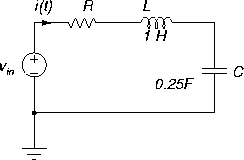 |
Load the series RLC circuit in PSPICE file rlc-trans.sch, Figure 24.
Exercise:
The current waveform is of the form

so you can find the valuesby measuring two data points for two successive peaks (where sine equals one), and doing some algebra:
Measure (i1,t1) and (i2,t2) at peaks (where
,
), form the ratio
and solve for
, and find
using t2-t1=T, where T is the period.
Note that the peaks trace out an exponential envelope (like amplitude modulation).
ANU Engineering - ENGN2211